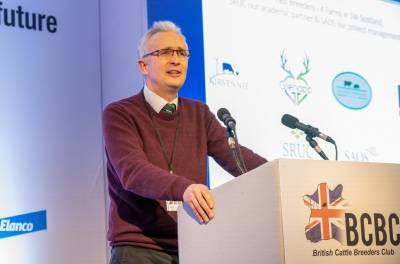
Dairy farmer Rory Christie from Dourie Farming Ltd in South-West Scotland has helped create the first crossbreeding index as part of the Fast Breeders Project, led by geneticist Mike Coffey from SRUC.
The project involves three other spring calving grazing herds milking a total of 4,250 cows.
Mr Christie says during the inception of the project they had the ‘very audacious goal’ to increase income by £1m/year/1,000 cows.
About the project
Since 2018 they have genotyped 9k animals to help create the index, alongside developing a culling tool which is helping them cull the right animals.
The genomic index is currently based on milk fat, protein and somatic cell count data but liveweight and calving interval is being added for the 23/24 season.
Mr Christie said he was disappointed to find only 50% of the heifers in the top 50% of the index.
“It is an expensive exercise. I carry nearly double the heifers I need for replacements, so we have a huge sum invested in additional stock per year.”
The other downside is that cow size is increasing rapidly. The genomic trend for maintenance, based on 90,000 weight records, is showing cow size will increase beyond the ideal of 525kg.
“They turned to Holstein to increase milk yield and consequently increased size,” explained Prof Coffey.
To understand cow size, all cows are being weighed twice daily after milking to get accurate liveweight data. This information has been used to create a maintenance sub-index.
“They now weigh all their cows regularly and send it to us at SRUC and we calculate genomic breeding values for liveweight. They use it to select cows for breeding and they also evaluate bulls they are planning to use using that SNP key. That means they can evaluate available bulls [based] on how big the offspring are likely to be when they mate those bulls to their cows,” explained Prof Coffey.
Fertility and maintenance are expected to be added to the Fast Breeders genomic index this year.
Next steps
Mr Christie now has an elite group of 500 females that are individually mated to sexed bulls with conception rates hitting 45%+.
But the plan is to accelerate genetic gain even further.
“We have been applying for funding to use ovum pick up from young heifers and embryo transfer so we can replace the entire bottom three-quarters of the herd with offspring from the top quarter,” said Prof Coffey.
Although they haven’t reached anything like their goal yet, milk yield is improving and is sitting just under 6,000 litres at Dourie Farming Ltd from circa 1t of concentrate.
Two of Mr Christie’s take-home messages were: “Increase selection intensity as far as you dare and only breed from animals that really make a difference.
“Size does matter, and breed does not. Hybrid genetics will drive us forward at pace.”
The next step as part of the project is to understand how genetics influences methane production.
Prof Coffey said the index is an exciting development for the wider dairy industry.
“One of the reasons I understand that a lot of people don’t crossbreed is because they can’t get genomic breeding values. With this project and the SNP key now established, it is feasible for other farmers who are already crossbreeding to genotype their animals and get genomic predictions.
“And other farmers that are not crossbreeding may be encouraged to do so because they know they can get genomic breeding values through this route.”
Prof Coffey and Mr Christie were speaking at the British Cattle Breeders Conference in January.